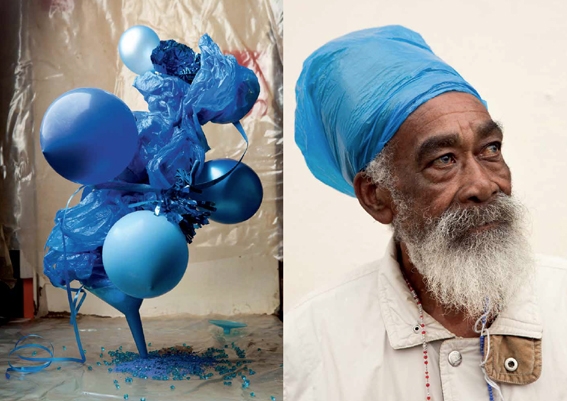Lorenzo Vitturi found his home and inspiration in the East London neighbourhood of Dalston, more specifically, in its local Ridley Road street market. His project, Dalston Anatomy, the first part of which was a photo book published last year under the same title, is comprised of photographs, photomontages and three central installations based on the market’s goods, structures, and content: fruit, vegetables, textiles, stalls, trinkets, and lastly, the local population. The language of the market is also present, as the words of a poem by local poet Sam Berkson that uses fragments of overheard conversations are printed on a large carpet in the centre of the gallery.
In his studio Vitturi built unstable structures from the market’s fruit and vegetables; some left to rot or covered with pigment; and then photographed them. With their element of precarious humour these images can resemble Fischli & Weiss’s photograph series Equilibres / Quiet Afternoon (1984), in which they arranged objects found in their studio in similar collapsing structures. The decaying vegetables and the ephemerality of Vitturi’s arrangements can be seen not just as a symbol for the market’s fast-changing temporality, but also as a memento mori gesture for the market itself, in terms of loosing its value as a necessary means of commerce and functioning more as a tourist attraction.
The Italian artist, formerly a cinema set painter, has created a highly aestheticised set for his show. The installations in the gallery, recalling market stalls, and the makeshift structures are meticulously designed with a remarkable sense of colour. But the political problematics of the exhibition can interrupt its beauty. In many of the photographs, portraits of local people are positioned next to images of vegetables and other market paraphernalia; some have their faces overlaid with shapes and colours matching those of the objects seen next to them. Particularly striking is an image in which the pigmented bald head of a dark-skinned man is positioned next to an image of an arrangement including a round spotted fruit, both set against a background of similarly spotted banana tree leaves.
With their familiar fruits and anonymous people Vitturi’s images might describe any other local market. What could have distinguished them as grounded in a certain locality are the individuals of the market themselves, but this oversimplified aesthetic of comparison, which deprives these people of their subjectivity, is not only surprising but can also be highly disturbing.
The text accompanying the exhibition situates the project as the outcome of the artist’s desire to ‘distil the area’s distinctive nature before it is gentrified beyond recognition’. But when the human texture of the market is presented as part of its goods, and its residents are compared to the commodities they are selling to make a living, Dalston Anatomy can appear less an authentic ‘visual ode’ to a ‘vibrant neighbourhood’, and more a romanticised still life of a still largely deprived socio-economic area, in which people are presented as exotic flowers or fruits.
Web exclusive, first published on artreview.com 2 September 2014
